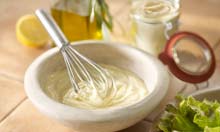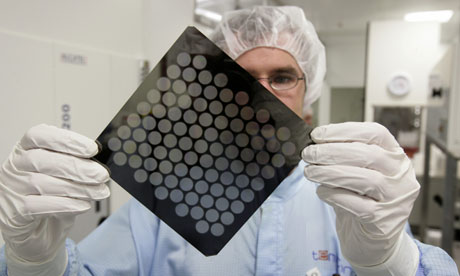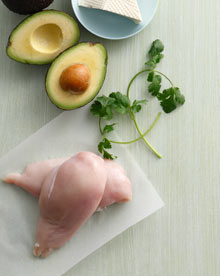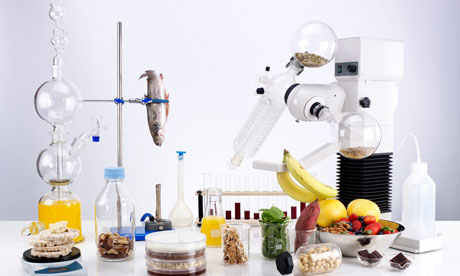Katharine Sanderson answers the big questions about the tiny technology on its way to your plate
 Mayonnaise is an emulsion of tiny particles, and researchers are developing techniques that allow these tiny droplets to be precisely tailored, to give them specific tastes or textures. Photograph: Philippe Desenrck/Getty Images
Mayonnaise is an emulsion of tiny particles, and researchers are developing techniques that allow these tiny droplets to be precisely tailored, to give them specific tastes or textures. Photograph: Philippe Desenrck/Getty Images
 A scientist with a master for the production of micro screens for use in the foodstuffs industry. Photograph: Ulrich Baumgarten
A scientist with a master for the production of micro screens for use in the foodstuffs industry. Photograph: Ulrich Baumgarten
 Until recently, industry has not been required to label products containing nanomaterials. But that is changing. Photograph: Cultura/Bret Stevens/Getty Images
Until recently, industry has not been required to label products containing nanomaterials. But that is changing. Photograph: Cultura/Bret Stevens/Getty Images
 |
| A variety of nanotechnology to be used in food is in development, and a few products have hit the market. Photograph: px photography/Getty Images |
What are the practical applications of nano-foods?
Nanotechnology is the science of the very, very small. Measured in billionths of a metre, nanoparticles are similar in scale to viruses, proteins and antibodies. You could fit thousands of nanoparticles inside just one of your red blood cells, leaving ample room to spare.
Manipulating food at this scale could help to develop lower-fat foods that still taste great, or allow manufacturers to pack more nutrients into otherwise vitamin-free foods. This technology should not necessarily be alarming, because the human body is already used to dealing with nanoscale food. Our guts break what we eat down to nano-sized chunks so that the body can absorb nutrients in the intestine, for example.
Nanotechnology is also poised to create better food packaging. It could reduce the amount of plastic used, for example, or make containers smarter by building in sensors that tell us whether the food inside is still fresh.
The food industry has unwittingly been using nanotechnology for years. Mayonnaise is an emulsion of tiny particles, where oil and water are forced to mix together without separating. But researchers are now developing techniques that allow these tiny droplets to be precisely tailored, to give them specific tastes or textures. Mayonnaise stays thick and creamy because "there are so many fat droplets that they divide the water into pockets", says Kathy Groves, a microscopist at contract research company Leatherhead Food Research in the UK. That means it is typically 70% fat – far from ideal if you're on a diet.
One way to reduce the fat content below 40% is to add more water, plus some starch to make sure the mayonnaise does not become too runny. But an altogether tastier approach is to manipulate the droplets' structure on the nanoscale. Groves and her colleagues are developing techniques to replace the insides of the fat droplets with water, creating an emulsion that has the same texture, but less fat than the real thing.
Researchers are also developing nanometre-sized grains of salt, roughly a thousand times smaller than normal table salt. Carving up a grain of salt into these smaller particles increases its surface area a million-fold, which means that your food needs far less salt to give your taste buds the same savoury kick. That could be a boon for those who, worried about high blood pressure, are trying to reduce their salt intake.
As for packaging, nanotech is already being used in the US to stop beers going flat. Plastic beer bottles used by brewer SABMiller contain flaky nanoparticles of clay, which fill up much more space in the walls of the bottle than molecules of plastic. That makes it much harder for fizzy carbon dioxide to escape from the beer – or for oxygen, which can spoil the beer's flavour, to get in. In future, smart nano-packaging might be able to change colour if it detects the gases given off by spoiling food, allowing consumers to make informed decisions about what's safe to eat.
Why would I eat nano-food?
 Mayonnaise is an emulsion of tiny particles, and researchers are developing techniques that allow these tiny droplets to be precisely tailored, to give them specific tastes or textures. Photograph: Philippe Desenrck/Getty Images
Mayonnaise is an emulsion of tiny particles, and researchers are developing techniques that allow these tiny droplets to be precisely tailored, to give them specific tastes or textures. Photograph: Philippe Desenrck/Getty Images
A variety of nanotechnology to be used in food is in development, and a few products have hit the market. But experts say that the traditionally conservative food industry is unlikely to adopt nanotechnology on a large scale unless it has compelling benefits for their business or their customers.
One of the main uses could be to deliver more vitamins and minerals through the food we eat. Nanoparticles could encapsulate vitamin supplements, which could be added to everyday foods such as bread.
Essential minerals could get the same treatment. "We're working to make nano-based iron supplements that are safe and side-effect free," says Jonathan Powell, head of biomineral research at the Medical Research Council's Human Nutrition Research centre in Cambridge, UK.
There is growing evidence that the body stores iron as solid, insoluble nanoparticles that are only broken down into useful atoms once they get inside our cells. Supplements containing iron in a soluble form can be toxic in very high doses, because they damage the gut. Powell wants to sneak iron directly into cells in their insoluble, nanoparticle form – piggybacking on the body's natural route – to make a more effective supplement.
Powell has also been investigating the health impacts of nanoparticles that are foreign to the body. Nanoparticles of titanium dioxide are commonly used in sun creams, where they screen out harmful ultraviolet rays. Powell has found that if titanium dioxide nanoparticles get inside the body, they can accumulate in parts of the small intestine used by our immune system. Although the health implications of this accumulation are not understood, Powell thinks that manufacturers should steer clear of using nanoparticle additives that do not have a clear benefit.
So where do nanoparticles end up if the body cannot break them down?
Researchers are just beginning to address that question. The UK's Food Safety Authority (FSA) has been running two projects that look specifically at what happens when nanoparticles are ingested and results are due in the next few months.
Sandy Lawrie, head of novel foods at the FSA, hopes the research will help companies planning to use nanotechnology test the safety of their products.
Aside from these studies, there is relatively little toxicology data on ingested nanoparticles, although that doesn't necessarily mean that the nanoparticles are dangerous, says Lawrie.
Who makes nano-food?
 A scientist with a master for the production of micro screens for use in the foodstuffs industry. Photograph: Ulrich Baumgarten
A scientist with a master for the production of micro screens for use in the foodstuffs industry. Photograph: Ulrich Baumgarten
Try to find out the details of what food companies are doing with nanotechnology, and you're likely to draw a blank. "The application of nanotechnologies in the food industry is at an early stage, and to the best of our knowledge the UK food and drink manufacturing industry does not currently use engineered nanomaterials in food products, their processing or their packaging." So says the UK's Food and Drink Federation, which represents food manufacturers.
Nestlé says that it is keeping a watchful eye on developments in food nanotechnology, but not doing any of its own research. Heinz takes the same line, saying that it is monitoring the field but not actively participating.
It was a rather different story back in 2005, when industry analyst Mark Bünger, a research director at Lux Research in San Francisco, California, attended the World Food Technology and Innovation Conference in Dublin, Ireland. In a report from the meeting, he wrote: "We talked with companies ranging from Unilever to startup Derevo about nanotechnology's applications in the food industry at every stage of the nanotech value chain."
Why have companies become so coy since then? Bünger suggests that it may reflect a genuine decline in interest, perhaps due to regulatory challenges. He expects that the nanotechnologies used to deliver food supplements, for example, will first make their way into medical applications, an arena where new products go through more rigorous testing.
This is backed up by figures from the Project on Emerging Nanotechnologies at the Woodrow Wilson International Center for Scholars in Washington, DC. In its inventory of more than 1,000 commercial products that contain nanoparticles, just five are listed in the food category.
But David Carlander, director of advocacy for the Nanotechnology Industries Association (NIA), based in Lisbon, Portugal, suspects that companies may be doing more work on nanotechnology than they are prepared to admit. "I think this is how several large corporations are acting, and the amount of 'monitoring' they do may in practice be quite substantial," Carlander says.
In 2010, the House of Lords committee on science and technology conducted an in-depth investigation of nano-food, and its report criticised the food industry for its secrecy on the subject. And last year, the Food and Agriculture Organization of the United Nations issued a report on food and nanotechnology which raised similar concerns about a lack of transparency about what the food industry was doing with nanotechnology.
Sandy Lawrie, head of novel foods at the UK's Food Standards Agency, says they encourage companies to come to them with information about what they've developed, but so far there have only been a "small number of enquiries" from companies developing new foods using nanotechnology. For all the promise of nano-foods, he adds, "there's a lot of talk about it but very few products to show for it".
Where does nano-food come from?
Some nano-structures occur naturally in food; others can be added by food manufacturers. But there's another way that nanotechnology can get into the food chain – from the ground up. At Clemson University in South Carolina, food biologist Jeremy Tzeng is using nanotechnology to tackle the problems that can be caused by feeding antibiotics to animals. The routine use of antibiotics in animal feed is banned in Europe, because microbes are becoming increasingly resistant to these essential drugs. This may, in turn, make human infections harder to treat.
Tzeng is developing nanoparticles that could take the place of these antibiotics in chickens. The particles bind to bacteria and then clump together, passing through the chicken along with other fecal matter. So far, the polystyrene-based particles he uses don't seem to cause the chickens any distress or weight loss, but there are still important issues to address. "Our concern is what the nanomaterial's impact is on the environment," Tzeng says.
That's not the only way that nanotechnology could be used on the farm. "Nanotechnologies are used to make various pesticides", says Kai Savolainen, director of the Nanosafety Research Centre at the Finnish Institute of Occupational Health in Helsinki, bringing with them a range of benefits. "They have a better ability to stick where they're supposed to – to roots, or leaves, or to weeds," he says.
Fertilisers can be delivered in nanoparticles that deliver the essential nutrients more efficiently. When conventional Fertilisers are applied to a field, more than half of the nitrogen they contain leaches away through the soil, or is lost in to the air, says nanotechnology researcher Maria DeRosa from Carleton University in Ottowa, Canada. Not only do crops miss out on their feed, this also increases nitrogen pollution that can cause unwanted algal blooms in waterways. Using Fertilisers in the form of nanoparticles could make it much easier for plants to absorb, drastically cutting down on the amount that farmers need to put on their fields. This could have other spin-off benefits – roughly 1% of the world's energy output is currently used to make fertilizer, so cutting back could reduce the greenhouse gas emissions the process creates.
Adding nanoparticles of titanium dioxide to Fertilisers could help to break down unwanted bacteria, while other nanoparticles have been used to slowly release chemical compounds that regulate plant growth, DeRosa adds.
Is it safe?
 Until recently, industry has not been required to label products containing nanomaterials. But that is changing. Photograph: Cultura/Bret Stevens/Getty Images
Until recently, industry has not been required to label products containing nanomaterials. But that is changing. Photograph: Cultura/Bret Stevens/Getty Images
In Europe, the arrival of genetically modified (GM) foods in the 1990s triggered a public relations disaster that has effectively closed the industry down. Nanotech advocates are desperate to avoid being tarred with the same brush.
"The parallels are undeniable," says Kathy Jo Wetter, who works on nanotech issues with the ETC Group, a campaigning organisation interested in technology's impact on health and the environment. "Products have been rushed to market without proper assessment and virtually no public discussion."
But even if they wanted to, food companies are not allowed to use clever new nanotechnologies in their products without regulatory approval. "Despite some earlier concerns that the use of nanomaterials in food was essentially unregulated, it is clear that nanotechnologies in food are regulated," says Diana Bowman, an expert in risk and public health at the University of Michigan.
All foods that include nanomaterials, or are processed using nanotechnology, fall under the same regulations as conventional food. The next challenge, which Bowman says hasn't yet been addressed, is to find out how effective existing regulatory frameworks are for looking at any novel effects associated with nanotechnologies. "This is still an open, and highly debated, question," Bowman says.
Until recently, industry has not been required to label products containing nanomaterials. But that is changing. The European Union recently introduced new regulations for cosmetics and food labelling, says Bowman. From the end of 2014, it will become a legal requirement to clearly label food products that contain nanomaterials – although the regulations do not cover manufacturing processes.
It's a move in the right direction, says Kai Savolainen, director of Nanosafety Research Centre at the Finnish Institute of Occupational Health. He says he is concerned that right now, food producers do not have to declare specifically whether they use nanotechnology. "I feel I should have the right to know what I put in my mouth," he says.
Savolainen says that while he doesn't anticipate any major risks from nanofoods, more safety studies that look specifically at ingesting nanoparticles are needed. "There are thousands of nanosafety studies, but very few of them can be used for risk assessment," he says.
European regulators are also trying to ensure that nanotechnology does not become the next GM. Forthcoming regulations on the oversight of novel foods are being rewritten to incorporate checks and balances for nanotechnology.
Bowman says that it is vital to investigate and debate the use of nanotechnologies in food now, rather than waiting until there is a consumer backlash. "Countries such as the US, the UK, the European Union more generally, Australia and New Zealand have been extremely proactive in examining the effectiveness of their regulatory frameworks for dealing with nanotechnologies," she says.
Fonte: The Guardian
